Release Date: January 28th, 1939
Series: Looney Tunes
Director: Ben Hardaway, Cal Dalton
Story: Tubby Millar
Animation: Herman Cohen
Musical Direction: Carl Stalling
Starring: Mel Blanc (Porky,) Ben Hardaway (Dizzy Duck), Danny Webb (Spooky Voice)
A general note before starting: up until this point, I had been formatting my reviews with a picture on top of its adjoining paragraph. Staring from hereon out, the adjoining picture will now be below the paragraph. I hope it makes reading these reviews easier and allow for a better flow, rather than pausing to recalibrate and figure out what goes where. On to the goods:
It's an Ill Wind pairs Porky up with yet another sidekick--the world renowned Dizzy Duck.
Dizzy Duck is not a new face to these cartoons. First established in Friz Freleng's She Was an Acrobat's Daughter, Dizzy serves as a sort of prototype for a coming character trope in the next handful of years: the blabbermouth. Friz Freleng would make his own Little Blabbermouse character, living up to Dizzy's shtick, and Chuck Jones' Sniffles would be retooled to be a talkative blabbermouth of his own in the early-mid '40s.
Dizzy seems like a Ben Hardaway magnet, who loves exhausting his jokes and loves his extraneous dialogue and indeed, there are dissimilarities between Hardaway (and Dalton's) Dizzy and Freleng's Dizzy. Bob Clampett would bring him back for a third and final time in Porky's Hotel, also released in 1939.
Ill Wind does debut something of note: a "Starring PORKY" title card. Granted, it's not much, just mere typography on the backdrop of the title card, but considering Bob Clampett would have exclusive title cards dedicated to Porky (and a few with Daffy, too), it is worth noting. Perhaps his "starring" role here was to grant the cartoon a sense of importance--it certainly would match the dramatic score of the Storm Movement from William Tell Overture.
Iris in to an establishing pan of a boardwalk. A nearby dog frolics past a smattering of Hardaway-isms on the nearby shops (such as DAVE'S SHRIMPS -- SHORT ORDERS or a no parking sign) before stumbling upon Porky and Dizzy, happily traipsing along to the jaunty score of "There's a Brand New Picture in My Picture Frame" with fishing rods in arms. The animation of Porky and Dizzy tends to glide, particularly at one point where they round a corner, not walking in the correct perspective until a beat too late.
In any case, they soon default to the correct perspective just in time for the bulbous, rubbery dog to approach them. Porky takes notice, and, in a very pleasant, kind-hearted introduction, grows belligerent.
"Eh-geh-gee-ge-g'wan home! Eh-geh-g'wan, you're a neh-eh-neh-noo-nuis-eh-neh-ne-eh-noo--you're a pest! Go on, eh-buh-bee-be-eh-beh-bee-beat it! Eh-seh-eh-seh-scram!"
Random dogs following characters and interrupting their outings is nothing new--it serves as the opening to Ain't Nature Grand! all the way back in the Bosko days--but to see and hear Porky get belligerent after the dog has done absolutely nothing nuisance worthy is confusing and unpleasant. Even having the dog bark once would be slightly more justifiable, but the Hardawayian tendency to add excessive dialogue (and poor voice direction for Blanc) do little to make Porky likable; a common theme throughout the cartoon.
Regardless, the poor pup obliges, a victim now of floaty, awkward, bloating timing as he backs into a corner and smells something.
The source of the stench is a rotting fish carcass in a nearby trash-can. For a scene intending to move the story along--or maybe Hardaway thought a dog nabbing a rotten fish was really funny and needed to be 13 seconds long--it sure drags for such an underwhelming payoff. A common critique in the Hardaway/Dalton efforts.
Rather than dissolving to Porky and his duck friend, the camera cuts straight back to them sitting at the dock, a rather abrupt transition between scenes and tone. Here, Porky recites the future wisdom of one Elmer Fudd:
"Neh-neh-now ya hafta be eh-veh-vee-veh-vee-vee-very, eh-vee-veh-vee-vee-eh-very, vee-veh-vee-veh-vee-eh-veh-vee-eh-very eh-ceh-cee-quiet."
Poor voice direction is a prevailing ailment throughout this cartoon, but it is worth noting that Porky's stutter sounds even more profuse than when Blanc was first starting out and purposefully imitating the profuse stuttering of Joe Dougherty as his successor. Porky's voice being pitched up slightly higher than usual does little favors to pad the blow.
In any case, accidentally annoying meets purposefully annoying. Dizzy Duck was first introduced in Friz Freleng's She Was an Acrobat's Daughter, where he talked throughout a movie showing by asking nonstop questions and getting yelled at by patrons. Acrobat, however, introduced Dizzy in small, intermittent doses, knowing that he was purposefully annoying, and it was best to dish up said annoyance in small batches so that it was still funny but not monotonous.
Entering the Hardawayian tendency to drag any and all things to the ground makes for a deadly concoction. There is no such restraint with Dizzy's talkative nature in this case, and so he succeeds in his mission of obnoxiousness with flying colors. Such as asking "WhydowehaftabequietPorkyfishescan'thearbeneaththewaterIneverseeafishwithearsonhowcanafishhearanything?"
For your sanity and mine, any transcriptions of Dizzy's dialogue will be typed out normally, but above is an approximation of what this cartoon entails for 7 whole minutes. Even Tex Avery, king of annoying characters, who used this very shtick in I Wanna Be a Sailor, ditched the talkative kid during the climax and had him say in a grown man's voice "Ain't I the talkin-est little guy?" as a signature self aware jab. No self-awareness or consideration for the audience's nerves is incorporated here.
Instead of a fatherly shushing, Porky aggressively jabs his chin towards Dizzy as a way to shut him up. Maybe that could work had Dizzy been consistently annoying him, but to see such an angry reaction out of Porky right out the gate--who absolutely does (or will) have a temper, but is usually the result of a build-up of events--is unpleasant and out of character.
That applies doubly when he literally chokes Dizzy for making kazoo noises. The choking part is quite funny, but not at all for its intended purpose.
While Dizzy rubs his assailed neck, Porky glowering as he miserably tries to fish, the puppy from before approaches with the dead fish in its mouth.
Enter a very poorly executed attempt at some bathroom humor (or so I believe is the intent.) Despite the stench passing by Porky first, Dizzy is the first one to notice the smell.
Porky soon notices, and glares daggers at Dizzy, as if accusing him of being the source of the smell. It's only when Dizzy has to physically motion to the dog behind him that Porky is able to piece together what's just happened.
Bathroom humor in a Looney Tunes short is odd as is, typically reserved for someone like Bob Clampett who could go overboard but somehow managed to pass it off in most instances. Failed bathroom humor is a bigger crime--the ambiguity of the entire scene makes it confusing and unconfident, with weightless, floaty, constantly moving animation obscuring things further. Maybe bathroom humor wasn't the intent, and Porky was about to ask Dizzy if he smelled it too, but the fact that this even begs such a question hints that the delivery of the gag is not clear.
What is clear is Porky's disdain for all things living the dog. Trying to be cute, the animation of the dog prancing on his paws reads as mindless and disconcerting with a blank, wall-eyed stare. His design doesn't evoke much sympathy, and neither do his actions.
Regardless, one does feel slightly sympathetic when Porky starts tearing the dog a new one. His fish bone is instantly dropped and therefore arbitrary as Porky launches into his tirade, telling him to go on and "Eh-gih-gee-eh-GIT!"
Awkward, grandpa-esque stomping ensues.
And that's the end of that. We then segue into the thrill of the cartoon; a rainstorm. Porky's insistence to avoid the storm prompts rapid-fire dialogue from Dizzy, clearly inspired by I Wanna Be a Sailor: "Oh boy, rain! I like rain. Dont'cha like the rain, Porky? It never rains in California! Aw, gee Porky, why do we hafta go? Fishes don't care if it rains, and I don't care if it rains, why should you care if I don't?"
In any case, Porky and Dizzy seek refuge in a broken down shack on the pier, a sign out front indicating it as a yacht club.
Judging by the tapered mouth shapes, tall oval eyes and general style of movement, Joe D'Igalo animates Porky and Dizzy's initial inspection of the decrepit shack. Porky cautions the age old question of "Anybuh-be-buh-bee-buh-be-body here?"...
...and is met with a deep, raspy, echoey reply of "No, there ain't nobuh-buh-buh-buh-buh-body here!"
Rather than getting scared that a voice had answered him back, Porky continues to investigate, any concern showing only when the door and windows slam shut, enveloping both of them in darkness.
Cue some good ol' fashioned sclera action, a cheap and fun way to get inventive with the acting. Sadly, Hardaway and Dalton don't take advantage of the glowing eyeballs, no head movements as they scout around for a light, no acting in the eyes. Instead, it's a quick reminder that the Hardaway/Dalton can sometimes get artsy, but even then, the pull of normalcy--symbolized as a match for our discussion here--is too strong to resist. Porky uses a match to light a candle conveniently in his possession, any artiness in the scene designated to the shadows.
The drawing of Porky shushing Dizzy isn't very appealing, but it's incredibly fascinating. Porky isn't a character who typically flaunts dynamic poses or sharp lines of action, so to see such an exaggerated pose, whether it be from the line of action or his cartoonishly prominent lips, is almost disarming. At least, it feels disarming in a Ben Hardaway and Cal Dalton cartoon.
Nevertheless, in a miracle of miracles, ambience is successfully struck in a Hardaway and Dalton cartoon. The moody shadows, the netting and wheel in the foreground, the broken windows and loose boards, low ceilings, furtive music score, and a lack of dialogue all, for a brief moment, successfully suspend the atmosphere and have a depth not usually present in the H-D efforts.
Sadly, that little gem of a moment is squandered when Porky and Dizzy hear a loud knocking noise nearby. Rather than playing the knocking for suspense, dragging it out and showing Porky and Dizzy's apprehensive reactions, we cut to the reveal right away, which is only the dog from before kicking the door with its hind leg.
It's back to regular H-D business when Porky tells Dizzy the place may be haunted. When Dizzy asks what that means, Porky clamps his beak shut with another meanspirited grimace.
Dizzy echoes the thoughts of the audience as he rightfully retorts "Well, ya don't need to get sore about it!"
Similar to the opening sequences in Porky the Gob, H/D struggle for a balance between atmosphere and their own humor, causing some odd waves between ambience and standard H/D fare. That lack of conviction can often be fatal, but here it's confusing if nothing else. The ambience is back in force when Porky cautiously opens the door, prompting a swarm of bats to spill out from behind. One of the bats who skirts in front of the camera seems to be a caricature of some kind, brandishing a mustache and hair.
There appears to be an odd splice once Porky and Dizzy press onward--the scene begins to fade to black, but then jumps to normal lighting once it cuts to the next scene without any sort of fade-in. It feels much too abrupt to be a shift in the lighting. Perhaps something got cut, a transition got lost in translation, or they decided they didn't want to do a fade and felt it was too much work to go back and re-shoot the footage to take the fade out. It's only a split second thing, but certainly leaves one wondering.
In any case, Porky stepping on a shovel, propping up a loose jacket and hat to make the appearance of a man and thusly getting scared by the apparition is a solid indication of the cartoon's remaining minutes and gags. Easier to judge now, when gags like these have become commonplace after the short was released, but it does beg for something a little more inventive or startling. The distortion on Porky and Dizzy as they do their takes is amusing, at the very least.
The trail of flames the candle leaves as Porky darts out of view is also a nice, artsy touch, with long, flowing curves. Of course, we don't see the full animation of the flame catching up to the wick (rather just a jump between two different drawings) but the effort is there.
While Dizzy is nowhere in sight, Porky has literally gotten himself hooked in another predicament. Knowing there'd be cartoons in the future where he refuses to believe a mute Sylvester's warnings about many a haunted house, it is almost funny to see him get scared of the fishing line hooked to his pants... though cartoons such as Frank Tashlin's The Case of the Stuttering Pig or Bob Clampett's Jeepers Creepers also star an easily frightened Porky, and those instances don't feel as out of character as it does here. Perhaps it's because the stakes aren't as high, but this cartoon does feel emptier in comparison.
As it turns out, Dizzy was hiding in a nearby corner. Spotting the fishing rod that's been knocked to the ground, he mistakes the activity for a fish on the other end. Thus, we cut to some glacial movement of Porky trying to outrun Dizzy's reeling, animation feeling relatively weightless and padding any danger the situation may pose.
And, as to be expected, the scene lasts twice as long as it should, cutting back to Dizzy remarking that he can't wait to show Porky his catch, and back to Porky hugging a nearby door. The grand reveal is not Porky flopping to his feet and getting dragged through the shack, oh no, but a piece of his jacket getting torn off in a very anticlimactic, leisurely manner.
For as much of a sucker as I am for ridiculousness in cartoons, the next bit of business--the hook catching on a bearskin rug, dragging it on top of a rolling desk chair, making it seem like a live bear is coming after Dizzy--lacks any sort of conviction or earnest behind it to make it funny. Improbability isn't necessarily the issue so much is the lack of faith the directors had in the gag. It very clearly feels like what it is--a rug on a rolling chair--and not what it could be. There's very little love in the execution of the gag, and its routineness betrays its inherent absurdity--a crushing blow in the world of cartoons.
Regardless, the shot of Dizzy reeling the bear in and running away from it is shot relatively inventively, with Dizzy in the foreground. It breaks up the monotony of the prevailing flat cartoon staging, as well as providing an avenue for the bear to swallow the audience a la Hugh Harman and Rudy Ising.
The lighting in the scene of Dizzy begging Porky to open the door is considerably lighter than the previous scenes, which serves as yet another jarring disconnect. In any case, Dizzy rips the doorknob off of its hinges, plowing the door down instead as the bear glides comically slow behind him, the frenzied music score serving as the most exciting part of the entire sequence.
Dizzy explaining his encounter to Porky is filled with more intriguing poses for Hardaway/Dalton standards; a pronounced silhouette as he imitates the bear's stance, as well as bending his beak physics to demonstrate the bear's fangs. Dizzy lines on Dizzy are also prominent once the bear rolls into the room where they're hiding, prompting the two to run.
Plenty of appealing drawings on Porky's run cycle, who feels more volumetric, solid, and appealing than he does in previous scenes. The art direction in the H/D cartoons tend to be on the mushier side, so any sort of solidity is much appreciated.
More criminally sluggish timing as Porky runs out of the shack and into the storm, suspended in mid-air. Any sort of alarm towards such a predicament is again absent, replaced by awkward scrambling as he shuffles onto a nearby flagpole. The bear plunging into the water below suffers from the same low stakes. Such a premise has a lot of potential to be made fun with fast cuts, interesting camera angles, and overall more exaggerated reactions and threats, but instead comes off as monotonous and routine. Hardaway and Dalton cartoons are rarely lauded for their confidence.
Another oddity of the cartoon comes from a cut to the puppy from before stalking a turtle that has never once been shown before. Introducing the turtle by walking across the scene in front of the puppy is a satisfactory introduction--there doesn't have to be any sort of Disney cuteness as the turtle pokes his head out of a hole in the wall--but here, the puppy is already pursuing the turtle. There's no form of introduction or establishment that the puppy is acquainted with this new friend until now. It reads as abrupt and confusing, but theater audiences were also much easier to please in 1939.
Noticing he has company, the turtle taps into the cartoon's prevailing mean spiritedness by biting the dog's nose and sending him flying into a nearby treasure chest, where a scuba diver's helmet lodges itself onto the pup's head.
The frantic shaking of the pup's head paired with the blank, unblinking, unfocused stare from inside the helmet make for a very humorous juxtaposition, but not in a way that one desires.
Such could be said for the dog struggling to escape from the helmet as a whole. Like everything else in the cartoon, a situation that begs to be exaggerated is played much too casually and unenthusiastically, causing moments where the dog's body spins around after trying to unscrew the helmet or flopping to the ground and getting his tail caught in a mousetrap to feel uninspired and monotonous.
At the very least, the vertical pan of the pup launching into the air and getting tangled in a chain pulley is innovative in its staging for H/D standards.
Rather than following the pup's new battle with the chains, the camera cuts back to Dizzy, who is now taking shelter behind a barrel. Hardaway and Dalton do get inventive in a fun take that is a little bit too wooden in its execution, but fun nonetheless: Dizzy overhears the chains rattling and gets scared out of his own skin, his conscience hopping into a nearby barrel and dragging his petrified shell in with him (despite a little double exposure trouble.)
Thus enters a game of cat and mouse between Dizzy and the dog, who also hops in an adjacent barrel. Both are terrified by each other, marked succinctly by many an exclamation line (and Dizzy's fervent, early '30s adjacent blinking.)
A pseudo game of Whack-a-Mole ensues, with Dizzy and the dog repeatedly getting scared, ducking for cover, emerging from a different barrel, rinse and repeat all the way until they wind up in the same barrel. Thankfully, the explosion of noise and movement that erupts when they both make a break for it convey a sense of urgency despairingly absent in the events preceding this.
Somehow, some way, Dizzy is sent flying through the air, down the cellar staircase, through a pile of clothes, and in front of a door. We never see what hit him or what caused him to be projected so far; Hardaway and Dalton used the concealing aspects of the dust cloud to their (dis)advantage.
The effects animation of the wind as Dizzy jars the door open is rather crude, the wind caricatured to look like snow pellets rather than a wind gust or even raindrops. Thankfully, Treg Brown's whistling wind effects (and Dizzy being sent airborne thanks to the umbrella hooked on his shirt opening and serving as a parachute) fill in any missing gaps, and the swirls of wind in the next scene as Dizzy is sent launching through the ceiling is much better.
Indeed, Dizzy is sent flying through the roof and into the rain, unconvincingly suspended in the air by the umbrella above. His cries to Porky are answered by a lightning bolt that strikes the umbrella, breaking it in half and sending him plummeting to the ground. Much like the dust cloud, H/D cheat the umbrella by showing it break in one frame, a white color card in the next frame to convey a lightning burst, and then having the umbrella be totally missing in the frame after that as Dizzy falls to his doom.
With all of these exciting thrills and chills, the audience is due for another dose of H/D gag sense. Here, Dizzy falls down the chimney of the shack, is sent tumbling out of the fireplace into the living room, and knocks into a nearby wall, prompting a framed portrait of a Napoleonesque figure to fall on top of him.
The disgruntled woodwind riff as Dizzy contemptuously taps his fingers, head protruding out of the ripped portrait, speak volumes for more reasons than one. A lack of hook-ups also make the gag abrupt and jarring--hook-ups shouldn't be a cartoon mandate, as some gags are strengthened by abrupt cuts and quick transitions, but here, that is not the case.
It's back to Porky, who's now struggling to open a hatch in the door. An attempt to get creative with some staging backfires in terms of clarity; Porky places his candle down on something nearby, which, in the next cut, is revealed to be the shell of the turtle, who unearths himself and waddles away. That the turtle has his candle is clear enough, but it would have been much clearer and easier to show Porky placing the candle down in that same close-up, with the wide-shot either absent or reserved just for him tugging on the rope, a truck-in and dissolve to the next scene serving as an adequate bridge.
Regardless, the oddest part of the scene isn't poor staging, but an overall lack of clarity and intent. The turtle struts past Porky with the candle, causing the flame to brush against Porky's rear and send him flying in the air. The burning of the candle feels like it demands a bigger reaction than it receives, whether it be from Porky or the physics of the flame in general.
Nevertheless, the turtle is completely absent once the camera pans back down to the ground, tracking Porky's movements as he scrambles aimlessly. Now, he falls through the opened hatch, leading him straight into the waters below.
Once again, Blanc's delivery of "Hey, eh-deh-dee-eh-deh-dee-deh-dee-dee-dee-dee-dih-dih-Dizzy! Help! Help!" as he aimlessly claws at an unanchored rope suffers from poor direction and being sped up too fast, sounding like another imitation of Dougherty's stutter than his own spin on Porky's voice.
The layout of Dizzy rushing to help Porky is eye-catching and inventive, being tilted at a diagonal angle helping to further a sense of flow, movement, stiltedness and action. Values in the color are nicely accentuated as well, with the black, inky shadows contrasting with the light gray boards of the stairs.
Dizzy does successfully pull Porky to safety... almost. To counteract the rope's excessive length, he continues to back up, back up, back up, landing right square in a manmade oil slick of kerosene, grease, oil, etc. Again, very routine and feels like a halfhearted barrier, but the one grease can labeled simply as "lotsa grease" did manage to jar a laugh loose from me.
As such, Dizzy is sent slipping in the slick, losing hold of the rope and tripping over the hatch, closing it shut. The sound effects of a splash in the water tell us all we need to know.
Frantically pulling on the rope, Dizzy reaches a dead end in a short amount of time... which is why a waterlogged Porky contemptuously tapping his foot right next to him comes off as even more abrupt. Had Dizzy tugged on the rope for a few seconds longer, the suspension of disbelief could work much stronger, but the pause feels much too short to be funny or plausible in the cartoon sense.
Poorly directed whines off-screen remind the audience that the dog is a part of this picture too. Whereas Porky and Dizzy make a break for it, the dog wrestles with his chains, sent plummeting down a set of stairs and crashing into a nearby pair of escapees.
Once again, a break in flow is caused by a lack of hook-up poses. The dust cloud seems to remain stagnant in the first shot, but the second shot shows it emerging from the yacht club. I realize these are incredibly minor nitpicks that nobody in the theater would have noticed, but they are worth pointing out just to study how shots can be made or broken by flow (or lack thereof.)
In any case, a happy ending it is. The rain is gone, the clouds parted, and the dog is freed of his scuba helmet.
Slipping in some last minute insults, Dizzy giggles "Boy, did he scare you!", gesturing towards the dog.
Mindbogglingly, in a scenario that seems it actually should warrant a defensive reaction from Porky, Porky instead continues to absentmindedly gawk at Dizzy as the duck asks "There wasn't anyone in there! ...Was there?"
Now, it's the dog's turn to be panicked. Blinking towards the camera as though he's forgotten something, the pooch is soon replaced with a trail of smoke as he darts back into the shack, whirring past a number of familiar layouts with speed a little too slow to be a convincing homage to Frank Tashlin's exhilarating montages.
Nevertheless, the pooch approaches the turtle from before, who still touts the candle on its back. He knocks on its shell a few times...
BAM!
A last dose of mean spiritedness for good measure as the dog literally bashes the turtle's head in with his fist. The dizzy lines on the turtle make for a rather appealing effect to close our cartoon on, which is marked not by an iris out, but a fade out, brought on by the dog blowing out the candle.
It's an Ill Wind is, unmistakably, a cartoon directed by Ben Hardaway and Cal Dalton. All of the earmarks are there. The confusion, the poor vocal direction, the mushy animation, the corny gags, the bloated timing, and an overall prevailing sense of half-heartedness. While not as ugly as a cartoon as, say, Porky the Gob, this cartoon does familiarize an audience with the shortcomings of the Hardaway and Dalton cartoons.
I've stressed this before, and I will continue to stress this in future cartoons, but not every H/D cartoon is unwatchable garbage. This was a cartoon I found funny when I was first introducing myself to these--when my biggest concern was that "Wow, these cartoons are in black and white, wow, Porky has a duck friend that's not Daffy", I thought his meanness was funny and that corny puns were hilarious.
Even now, I remain more sympathetic to these cartoons than I should be. It takes a lot for me to truly hate a Porky cartoon (and the ones that I do hate are because they're overwhelmingly racist or offensive in some way), and I enjoy these efforts more than the average historian--if one would call me that--does. I think Porky looks cute in certain shots, I like the musical orchestration, some of the layouts are genuinely eye-catching, and there does seem to be an attempt at some atmosphere, even if it backfires. This beats a Ben Hardaway Buddy cartoon by miles.
Still, it's marred for the reasons I listed above, which aren't exclusive to this cartoon. Dizzy Duck in particular is the perfect recipe for disaster in a Ben Hardaway short; as mentioned previously, Dizzy's annoyances in She Was an Acrobat's Daughter were carefully spread throughout, and there were parts of the cartoon where he was getting into stuff while silent, acting like a curious little kid. Here, he's just an obnoxious pest.
Unnecessary grouchiness is my biggest complaint with the cartoon; I've always thought that Porky was one of the most violent characters in these cartoons, and I enjoy when he is violent and mean, but here there's absolutely no reasoning for him to be so grouchy. Daffy causing him to pitch a tent in a lake, stealing his food, reminding him that Porky can't hunt him, smashing signs over his head, causing him to get beat up by mother eagles, making Porky blow himself up and plummet feet to the ground IS a reason for him to get violent and angry. A dog wagging its tail and bringing a present is not.
I can't say I'd recommend this cartoon, but it does have the novelty of Porky being paired up with yet another failed sidekick--first Beans, then Gabby, then Dizzy. This comes as doubly odd after Daffy has slowly been making a name for himself as Porky's partner in crime, and would continue to do so in the coming year. To see Porky paired not only with yet another sidekick, but another duck sidekick, is an oddity of a novelty in itself.
Enjoy! The cartoon is also available on HBO Max.








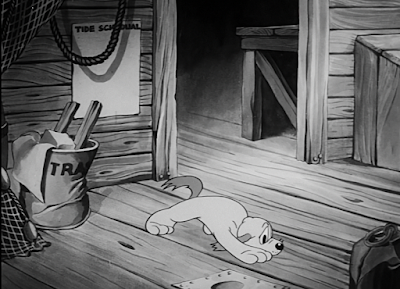




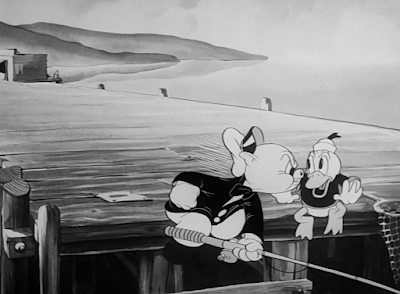



































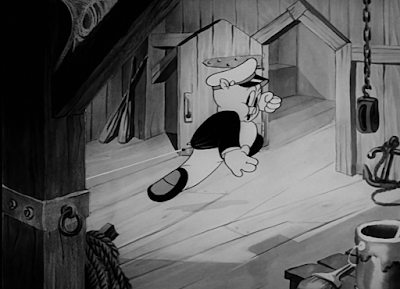




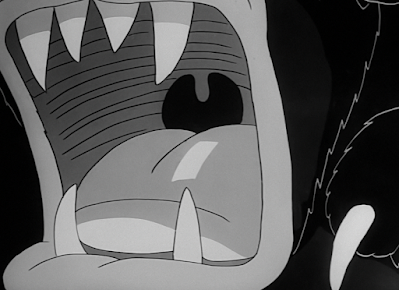



























































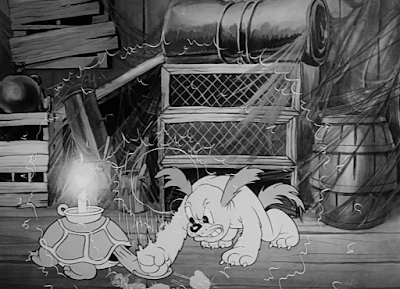





No comments:
Post a Comment